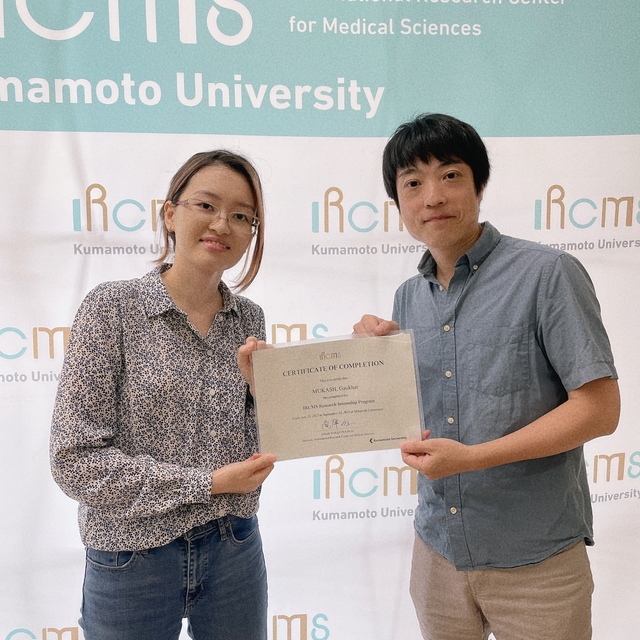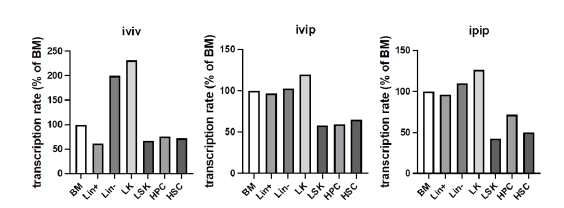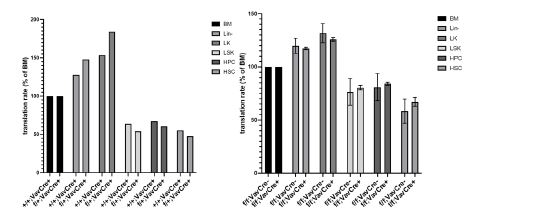- HOME
- Education
- Student's Voice
- 【IRCMS Internship】Ms. MUKASH, Gaukhar (University of Eastern Finland)
Student's Voice

Name: Gaukhar Mukash
University of Eastern Finland
Visiting Period: July 24th (Mon) - September 16th (Sat), 2023
Country: Finland
Lab: Laboratory of Proteostasis in Stem Cell
Summary
The final report is aimed at summing up all the activities performed at IRCMS, and results obtained during the internship.
Objectives
The objective was to conduct an experiment with a relatable topic as a part of ongoing projects at the lab. For this purpose, we selected a study of HSCs' homeostasis and quiescence in heterogeneous nuclear ribonucleoproteins (hnRNPs) U knockout mice. hnRNPs play role in alternative splicing, mRNA transcription and translation, and other cellular processes. Here, we compared transcription rates in hematopoietic progenitor cells (HPCs) and hematopoietic stem cells (HSCs) cells in control and KO mice.
Overview of experiences and skills developed
To perform series of experiments I was guided with the following lab techniques and methodologies:
- Rodent Handling, injections and sacrificing. I developed hands-on skills in handling
laboratory animals and performing ethical animal sacrifices for research purposes. Before entering the animal facility, I was provided with an online course on the University Moodle website in English and with corresponding video materials. I also gained proficiency in performing injections in rodents, including intravenous (i.v.) and intraperitoneal (i.p.) injections, and blood collection from tail vein and venous sinus by removing eyes for further blood analysis.
- Mouse bone marrow extraction. This process involved meticulous steps, including dissection to understand the anatomy, carefully removing essential bones such as the hips, spine, femur, and tibia, and subsequently placing them in D-PBS for further analysis.
- C-kit enrichment. This procedure is needed to separate HSCs from other cells. CD117 is expressed on HSCs and germ cells, but upon differentiation expression is lost. CD117 expressing cells are positively selected using Magnetic Activated Cell Sorting (MACS).
- Click-it reaction is used to detect nascent global RNA synthesis using 5-EU. This experiment consisted of preparing reaction buffer and mixtures.
- FACS analysis was the final step of all experiments. I learned how to setup the machine and software before use. Then I learned how to do the gating and compensation for different staining markers. For the 5-EU experiment we had 5 populations based on cell surface marker expressions which are HSC, HPC, LSK, Lin+ and BM. Each of these cell populations were sorted based on the expression of certain markers.
Accomplishments and projects
First, we conducted 3 experiments with 5-EU to see the difference between transcription rates in different stem cell lines to assess the viability of the method. However, there was not a significant difference between the injected and non-injected mice on FACS analysis as shown on the Figure 1. Actually, 5-EU injected mice showed even lower uptake of 5-EU. So we decided to use verapamil, a calcium channel blocker that decreases efflux of the 5-EU.

Figure 1. In vivo transcription rate measurements of BM lineages iin 5-EU mouse. BM: bone marrow, LK: c-kit low, LSK: Lin-, Sca-1+, c-kit+, HPC: hematopoietic progenitor cells, HSC: hematopoietic stem cells The use of verapamil was expected to increase difference in transcription rates in injected mice. In our pilot experiment we observed that HSCs had higher TR compared to HPCs which aligns with our expectations (Figure 2).
Figure 2. In vivo transcription rate measurements of BM lineages in 5-EU mouse injected with Verapamil. BM: bone marrow, Lin+: cells that express linegae specific markers e.g. CD3e, Lin-: cells that do not express lineage specific markers (B220, CD3e, Ter119, Mac1, Gr1), LK: c-kit low, LSK: Lin-, Sca-1+, ckit+, HPC: hematopoietic progenitor cells, HSC: hematopoietic stem cells.
However, when repeated the results were not consisted with pilot experiment. It was suggested that we try different injection modules alternating between IV and IP. We used 3 mice that received equal amounts of 5-EU and verapamil either intraperitoneally and/or intravenously. During the injection process a mouse that received both substances IV died within several minutes, but we still decided to use it for analysis. As shown on Figure 3, there is no significant difference between mice that have received verapamil by IV or IP.

Figure 3. In vivo transcription rate measurements of BM lineages in 5-EU mouse injected with Verapamil. Different injection routes a) IP & IP, b) IV & IP, c) IV & IV
The results varied substantially between iv and ip. For example, in IPIP mouse HPC has higher transcription rate compared to the HSCs which is contradictory to the pilot experiment results. In IVIP mice transcription rate in HPCs and HSCs are almost the same. There are several potential limitations which are leading to the difference in results such as the source of the reagents and the protocol. Therefore, the experiment is expected to be repeated after some revision on protocol.
Next, we decided to look at the translation rate of HSCs. For this reason, OPP (O-propargyl-puromycin), an analog that incorporates into newly synthesized polypeptides was used.
Figure 4. In vivo translation rate measurements of BM lineages in hnRNP KO mice injected with OPP. +/+: homozygous wild type, f/f: floxed allele, VaVCre+: Cre recombinase transgene
Figure 4 shows that the translation rate is higher in homozygous floxed allele VaVCre+ mouse compared to VaVCre- which is aligning with our expectations. It was assumed that KO mouse will have higher translation rate because of the altered splicing and translation control. It is also possible that there are compensatory alternative pathways for mRNA modifications which can be carried out by other proteins of hnRNP family.
Conclusion
The preliminary results of our experiments suggest that hnRNP U has a role in the maintenance of stem cell regulation to some extent as the complete KO mice showed an increased translation rate compared to heterozygous KO and WT mice. The further prospects will be comparing transcription and translation rates in male and female mice as there is a difference in survival of KO mice between male and female. Sex specific hnRNP U expression and regulation can be attributed to the hormonal difference and it is the ground for further investigation.
Acknowledgements
I express my heartfelt gratitude to Dr. Kenichi Miharada and Dr. Kiyoka Saito for their invaluable guidance, mentorship, and unwavering support throughout my internship. My sincere appreciation extends to the IRCMS for providing me with this incredible opportunity for learning and growth.


